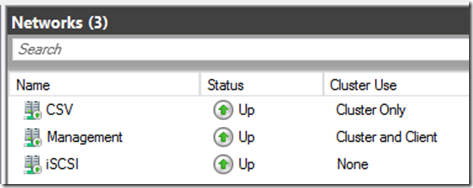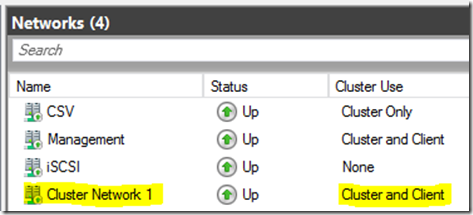Cluster Networks in Windows Failover Clustering
Welcome to the Ask the Core Team blog. My name is Eriq Stern and today we are going to discuss Failover Cluster networks. This information applies to Windows 2008 thru Windows 2012 R2 Failover Clusters.
What does a Windows Failover Cluster consider a “Cluster Network”?
In a Windows Failover Cluster, Cluster Networks are created automatically by the Cluster Service for each configured subnet on any active network interfaces (NICs) on each node of the cluster. If a single node has a NIC configured with a subnet that is not configured on other nodes, a Cluster Network will be created even though it cannot be used by any nodes that do-not have an active NIC on it. Disabling any NICs on a single node has no effect on Cluster Network objects if there are still active NICs on those subnets on any node. To remove or re-create a Cluster Network, all NICs on the desired subnet must be disabled or removed until the Cluster Service discovers the change and removes the related Cluster Network, which should happen within a few seconds of disabling or removing the NICs.
How are Cluster Networks configured for cluster use by default?
Cluster Networks are always enabled for Cluster use by default when created, even if the same network has been previously configured otherwise. If the network has a default gateway, then it will also be enabled for Client use. This is because when all NICs on a subnet have been removed or disabled, the network is completely removed from the cluster database, and is re-added as a new entry if the network is rediscovered. Because of this, in some cases it may be necessary to reconfigure a previously configured network after a Cluster Network has been removed and re-added, for example after disabling and re-enabling a NIC on a single-node cluster.
How are Cluster Network names/numbers determined?
Cluster networks are automatically named “Cluster Network” followed by the next available number that is not assigned to an existing network. For example, if “Cluster Network 1” exists, a new network would be named “Cluster Network 2” – but if “Cluster Network 1” has been manually renamed, when another NIC is enabled on a different subnet, a new Cluster Network will be created and automatically named “Cluster Network 1”. The number will not be incremented based on the previously identified networks.
Manually renamed Cluster Networks:

I hope you find this information useful.
Thanks,
Eriq Stern
Support Escalation Engineer
Windows High Availability Group
Comments
- Anonymous
February 23, 2017
Hi Eriq,I have 2-node Windows 2008R2 Failover cluster, On each node, i have configured NIC teaming. On one of the node If the primary NIC fails and secondary NIC becomes active, will that trigger Cluster to Failover ? Please adviseI'm using Broadcom Advanced control Suite to configure the interfaces in Teaming.- Anonymous
February 23, 2017
In theory, you should not get a failover if the NIC team has to failover to the secondary NIC. Now, if the teaming software reports up the TCP stack that it disconnected, this can cause the network to show a failure in Failover Cluster and cause a failover. It's best to consult with the NIC/Teaming vendor for their recommendation of how to setup the team properly for a Failover Cluster.
- Anonymous
- Anonymous
June 15, 2017
How does an external request to the Cluster Network IP gets to the correct node?I can think of two possibilities, either- any request to the Cluster IP goes to Active Directory, then, AD makes the request to all the Cluster Nodes and only the Active Node respondsor- when the Cluster service starts or a fail over occurs, the Cluster service tells the Active Directory which IP (or MAC Address, or "Server Address") to redirect all requests going to that Cluster IPI am a SQL DBA. The question sounds simple but nobody I talked knew for sure.- Anonymous
June 16, 2017
The ARP table on the switch has a mapping of the IP address to Physical address of the actual NIC. So when cluster brings an IP address online, we send out an ARP to register that the IP address matches the MAC address of the NIC in the node.
- Anonymous
- Anonymous
July 04, 2017
The comment has been removed - Anonymous
November 01, 2017
Hello, I am new to clustering and need information on how to configure a Win 2012 multi site fail-over cluster for SQL AlwaysOn 2016. Will have 2 servers in main data center on one VLan and another one in the DR site on a different VLan.Is it there a document to detail the configuration? Mainly the IP address configuration/requirements for Windows cluster configuration?Thanks,George - Anonymous
February 21, 2018
Is the behavior in 2016 fail-over clusters different ? - Anonymous
January 04, 2019
I have a 3-node cluster. Each member has 8 NICs. I teamed NICs 1 & 2 on each of the nodes for my "production" network using a subnet range of 10.2.0.X/24. Then configured NICs 3 & 4 on all 3 nodes for iSCSI and placed them on a separate switch using 10.4.0.X/24. In addition to that I teamed NICs 5 & 6 on each node for Live Migrations on subnet 10.6.0.X/24. Also configured NIC 8 on all 3 nodes for a heartbeat link using 192.168.0.X/24. At one time using Failover Cluster Mgr. I was able to see all 4 networks but now I only see 3. For some reason the "MS Network Adapter Multiplexor Driver-Virtual Switch" (my production network) is showing up in Failover Cluster Mgr., under Networks, in my iSCSI network (Network 2) and what used to be Network 3 (production network) is gone. I have gone over my NIC setups several times to make sure all details are correct as far as subnet MASK and GTWY but I do not see where the problem might be. Can you help?
